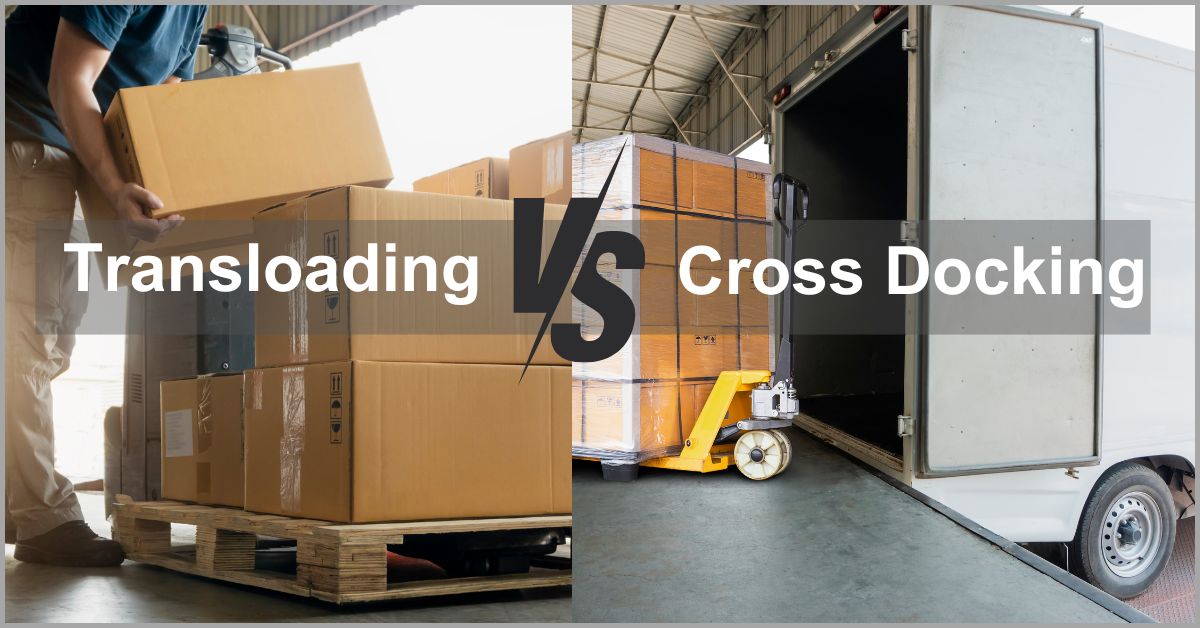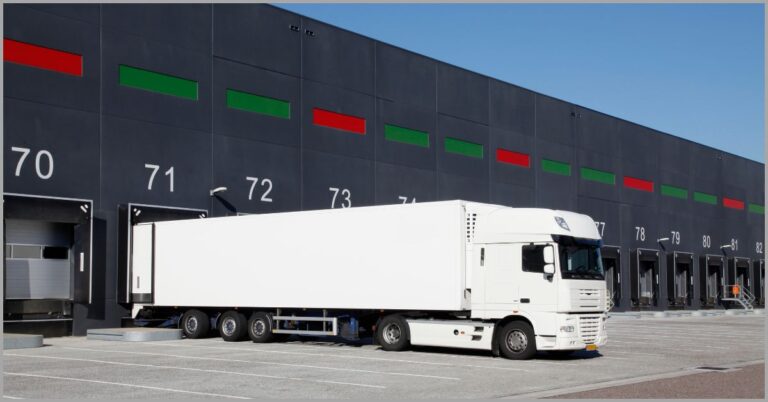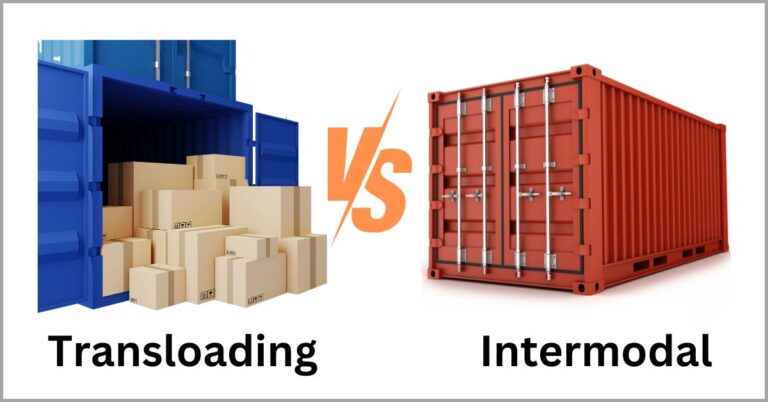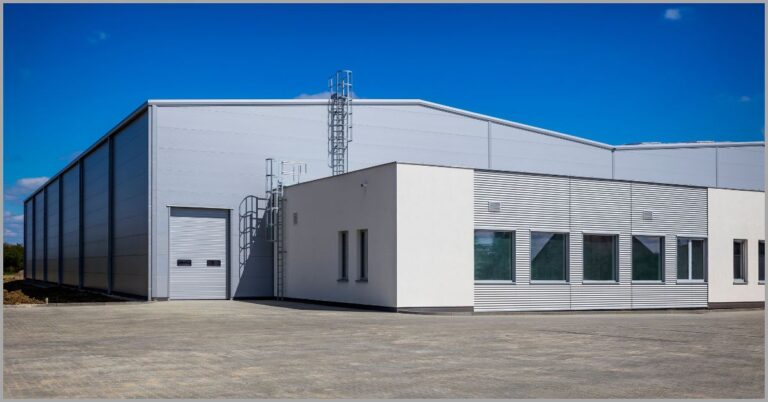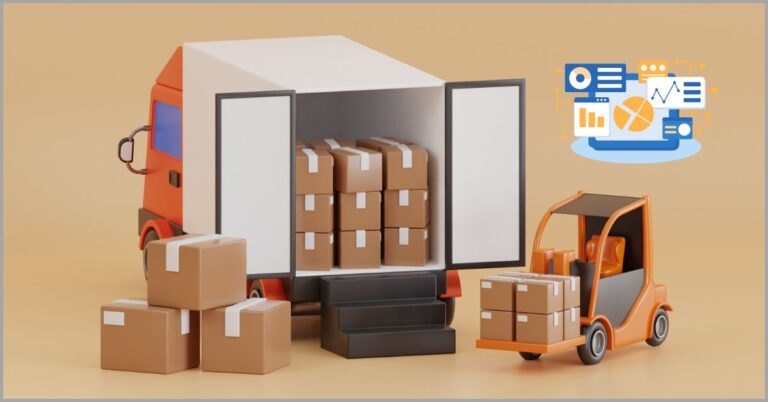Transloading vs Cross Docking: 5 Main Differences & How to Choose a Service
Searching for a great business shipping strategy?
Cross docking and transload freight shipping are often used interchangeably.
However, transloading and cross docking are different, and failing to use the right shipping approach can lead to supply chain disruptions for your business.
Interestingly, a recent survey by Logistics Hall of Fame revealed that 48.7% of logistics experts struggle with disruptions, and poor shipping strategies are partly to blame.
In order to avoid disruptions and the losses they bring, we’ll dive into the transloading vs cross docking discussion to understand the strengths and weaknesses that each shipping strategy brings to the table.
This information will enable you to choose the right service for your business to reduce the risk of disruptions and ensure excellent efficiency for your supply chain.
If you’d like to learn more about making your supply chain efficient, check out this article I wrote on the main transloading challenges and their solutions.
In this article, we’ll discuss the main differences between transloading vs cross docking and how to choose a service that’s most suitable for your shipping needs.
Let’s get started.
What is transloading and cross docking?
I. Transloading
What is transloading all about?
It is the process of transferring goods from one form of transportation to another. For example, you can receive freight from a rail car, and transfer this cargo onto a truck which will then ship it to the next phase of your supply chain.
In transloading, you may need to store goods in a warehouse temporarily, which can improve cargo availability by storing goods close to your market.
So this makes a key difference between transloading vs cross docking, with the latter operating on a just-in-time principle that removes the need for a warehouse altogether. Transloading, meanwhile, allows you to wait until a carrier is available.
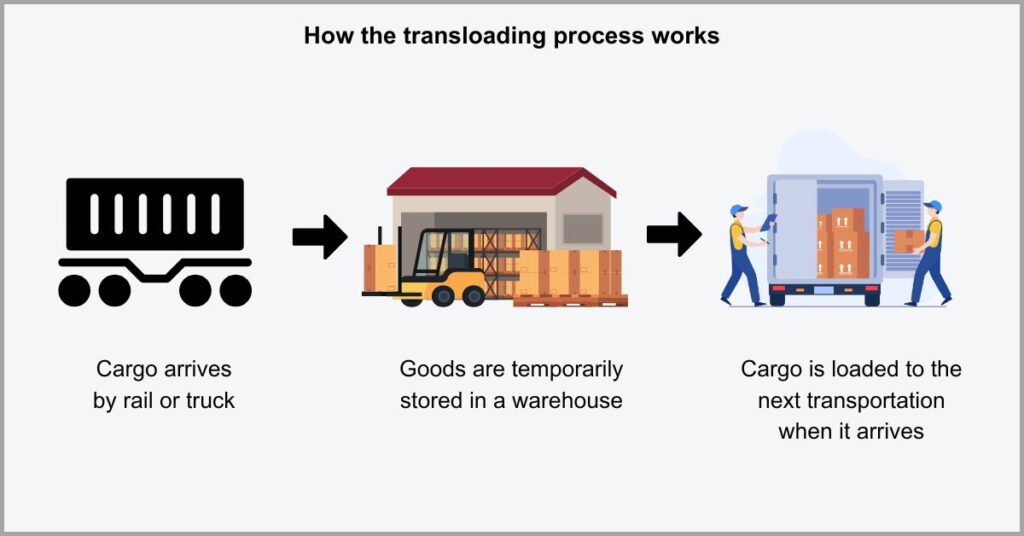
If you’re looking to start a warehouse business, transloading therefore attracts bigger capital investments since you’ll need to purchase larger amounts of warehouse space.
That said, it’s a great strategy for overcoming the limitations of one form of shipping.
In cases where it may not be possible to transport goods from the start to the end points of the supply chain by sea, for example, transloading enables you to switch to alternative transportation like rail or truck so you can eliminate geographical barriers.
You may also do it to minimize the cost of transportation by switching to a less expensive means of transportation like long-distance rail freight hauling.
II. Cross docking
So what is cross docking exactly?
It entails the transfer of goods from one form of transportation to another with little to no warehousing involved. The key difference with transloading is that you unload goods directly from one transportation medium to another at a cross docking facility.
By leveraging cross docking strategies for your business, you can dodge shipping delays and move freight quickly to your target destination.
Let’s demonstrate cross docking with an example for clarity.
If you’re a large retailer like Walmart, you can ship a single and large rail shipment destined for smaller stores. At a cross docking terminal, your shipment will be split into smaller loads and loaded directly onto different trucks heading to each store.
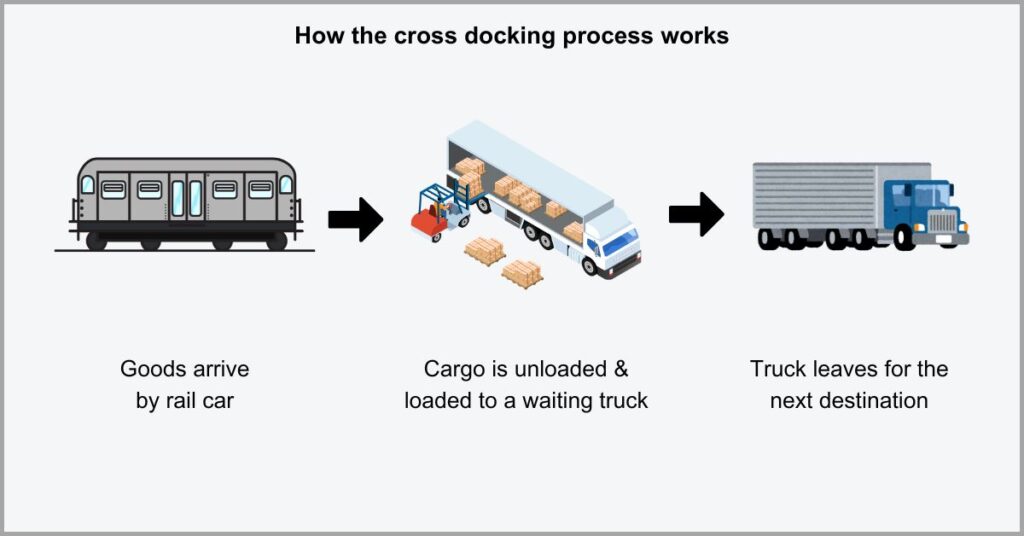
Cross docking is one of the top freight brokerage strategies, because it essentially allows you to run a business even when you have limited warehouse space.
When it comes to transloading vs cross docking, this difference of storage means that cross docking tends to achieve faster shipping outcomes in comparison.
Therefore, it’s a more ideal strategy when you’re looking to ship freight that is highly perishable or fast-moving. Alternatively, it may also be a great fit for cold-chain cargo and other time-sensitive goods as well.
Cross docking also minimizes additional processes such as warehousing and cargo sorting, which can attract extra shipping expenses for your business.
Differences between transloading and cross docking
1. Repalletization of items
Transloading may involve item re-palletization.
Re-palletizing involves breaking down pallets into boxes and other bulk units of goods, and sorting them for storage or transfer to a new form of transportation.
So transloading enables you to consolidate shipments heading to different destinations into one pallet, to help get around the very high freight rates.
A study by Statista showed that $5,900 is the average freight rate globally. This represents a sharp increase, considering that in October 2023, you’d pay about $1,342 for the same 40-foot container.
This statistic proves just why transloading is important. Through repalletization, it makes it easier to combine multiple orders and split freight costs with third-parties.
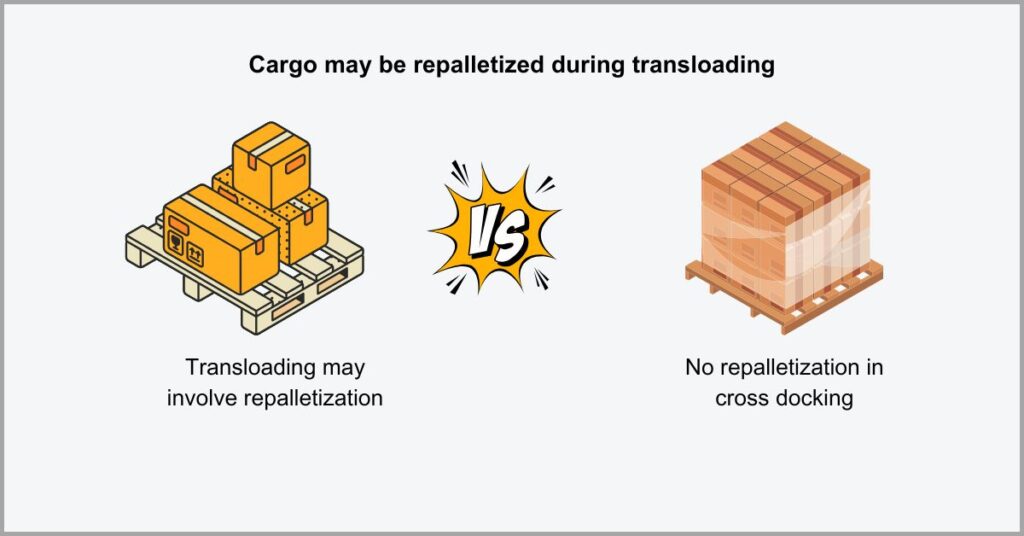
Do you repalletize goods in cross docking?
No. During this process, you transfer cargo without breaking down individual pallets.
So this makes up a very key difference in the transloading vs cross docking discussion, with cross docking usually keeping the pallets intact, whereas transloading may involve freight deconsolidation and repalletization.
If you run a transload warehouse and are looking to provide additional services like cross docking, we can help.
Click here to get our premium support services that offer guidance so you can figure out whether cross docking is a feasible venture.
Beyond that, we’ll advise you on how to improve yard operations and turbocharge efficiency for your transloading operations to increase throughput and revenue.
2. Inventory holding
Are goods stored in a warehouse during transloading?
Yes. When it comes to transloading, you’ll typically move cargo from your rail car or truck into the warehouse for temporary storage until the next form of transportation, which may not be readily available, arrives.
While transloading allows you to decentralize your supply chain, the need for warehousing can mean additional logistical expenses for your business.
In 2024, warehousing costs $8.31 per square foot compared to $6.53 in 2017, according to a study by Warehousing and Fulfillment. If I crunch the numbers, this translates to a 27% increase.
So transloading therefore attracts costs like warehousing which may be lower or non-existence in cross docking.
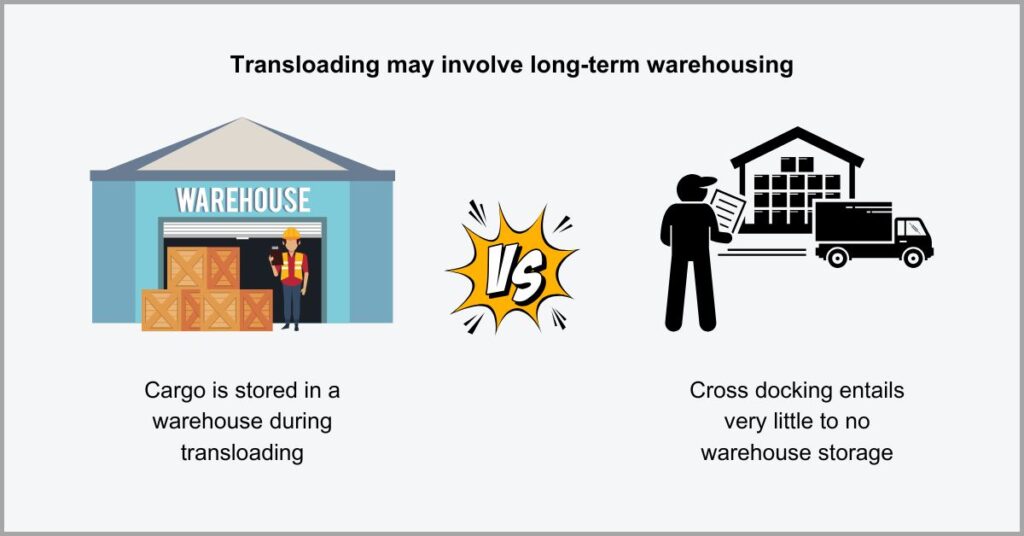
Conversely, cross docking rarely involves warehouse storage.
While such facilities may still have a warehouse, you’ll notice that it’s primarily used for sorting purposes to determine which pallets go to which truck after performing inventory reconciliation.
Speaking of which, I recommend using B2B inventory management software to improve inventory visibility during transloading or cross docking processes.
That’s because it’s still possible to store goods in a warehouse during cross docking in case the next mode of transportation is unavailable.
However, the key difference between transloading vs cross docking here, again boils down to storage durations. Cross docking may involve very little to no inventory holding while transloading typically involves longer cargo storage durations.
3. Shipment volumes
Transloading enables less-than-container load shipping (LCL).
LCL involves the shipment of cargo that isn’t enough to fill a standard 20-foot or 40-foot container, and it allows you to ship smaller volumes of cargo more frequently, instead of waiting to hit a certain shipment size.
So transloading enables you to deconsolidate freight and send it out in smaller LCL shipments, which results in excellent supply chain flexibility.
A study by Mordor Intelligence reveals a 3.5% growth rate for the less-than-container load market. One of the trends driving its popularity is the need to ship fluctuating volumes of cargo because of volatile demand.
Transloading facilitates this by enabling you to deconsolidate or consolidate freight accordingly.
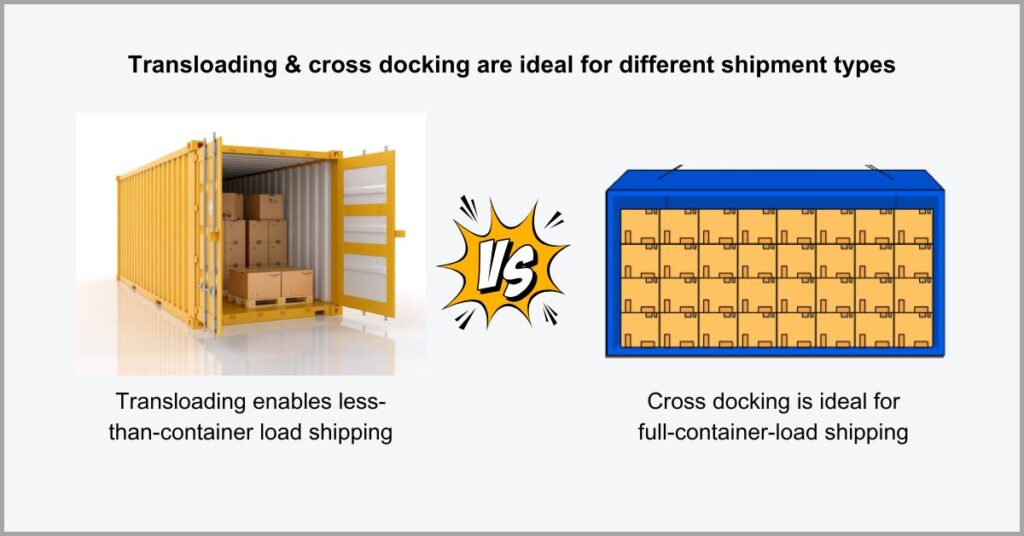
What type of shipment is cross docking great for?
It is generally ideal for full container load (FCL) shipping, where your cargo occupies almost the entire space of the intermodal shipping container.
That said, you may also find this transloading vs intermodal shipping article useful, if you’d like to learn more about intermodal shipping containers.
One reason why cross docking is suitable for FCL shipping is because the freight typically belongs to one owner, which means that there may be no third-parties to split shipping expenses with.
So if you have huge volumes of cargo that can garner full container loads, cross docking therefore proves more suitable than transloading.
4. Ownership of cargo
Who owns the freight during transloading?
It is possible for you to combine shipments with multiple other consignees during transloading, which means that the freight involved typically has cargo that’s owned by two or more consignees.
Due to the multi-ownership state of cargo, transloading can introduce the risk of inventory mix ups that may lead to clients receiving the wrong item.
A survey by PowerReviews revealed that 88% of consumers return goods sometimes. Some of the leading causes include inaccurate order fulfillment, which can occur during the transloading processes.
When done accurately, however, transloading enables you to split costs with multiple other consignees, helping you to cut back on your shipping expenditure.
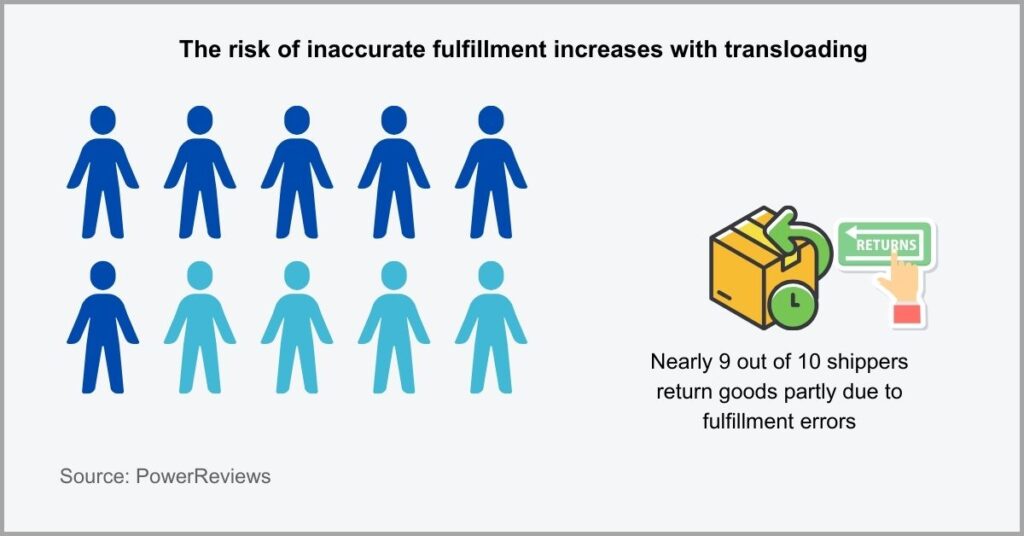
On the other hand, cargo is typically owned by one consignee during cross docking.
That said, it is also possible to merge shipments with different consignees during cross docking. The key transloading vs cross docking difference, however, is that transloading typically ropes in more consignees in comparison.
Either way, having a great transload management software can be a life-saver.
Click here to start your free trial of transloads.co, which can help you improve shipping efficiency when handling multi-owned shipments and different types of cargo.
With our software, you can improve outbound and shipment tracking, down to individual owners and cargo types, thereby minimizing errors to ensure more accurate fulfillment.
5. Handling of goods
Transloading also increases the handling of goods.
With this shipping strategy, transloaders will perform changeovers at various terminals or warehouses. If your freight was consolidated with orders for other cosigness in the same pallet, there will also be need for repackaging.
Given how transloading increases material handling, this shipping strategy greatly increases the risk of undermining the integrity of the shipment.
It’s the case today that 28% of all cargo integrity issues result from the physical damage of goods, according to a Recoupex study. Some of these incidents occur due to poor handling during transloading.
Despite the risk, transloading is sometimes necessary because it modifies the packaging to optimize the shipping process.
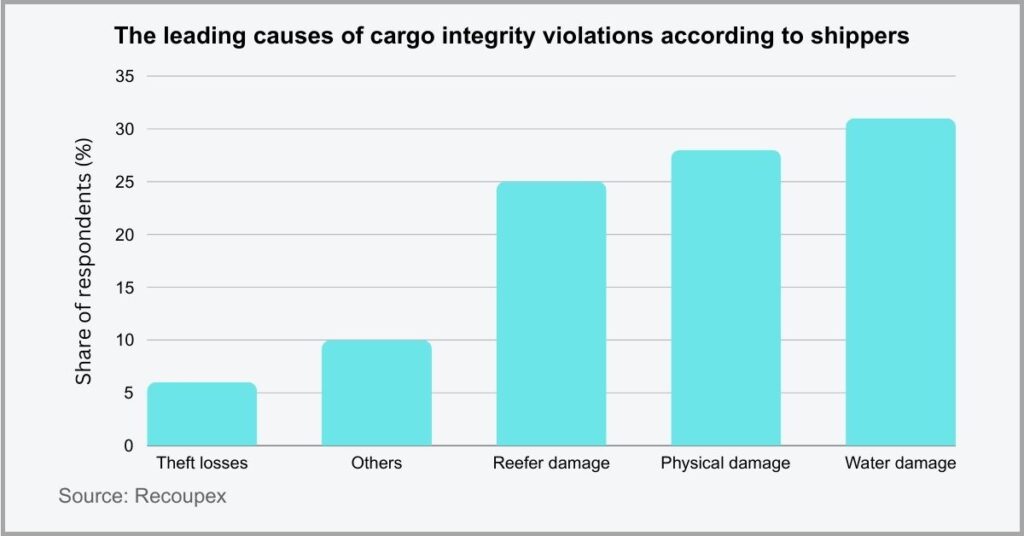
What about goods handling in cross docking?
Well, it involves very minimal material handling because you transfer an intact pallet from inbound to outbound vehicles without repacking of any kind.
This means that dock workers won’t get to touch individual units of goods with your pallet, which helps to reduce the risk of cargo damage, prevent inventory fraud and generally improve shipment integrity.
As a result, it’s one of the most popular railroad logistic strategies if you’re moving fragile cargo or freight that requires very minimal disturbance.
This includes fragile commodities like porcelain, marble and electrical equipment with screens as well as touch-sensitive goods like foods and pharmaceuticals.
How to choose between transloading & cross docking
a) Weigh urgency against savings
So transloading vs cross docking, what will it be?
If you’re looking to move cargo that isn’t very time sensitive, transloading is right for the job in this case.
That’s because your supply chain won’t be disrupted by the need to temporarily store goods and the time that goes to freight consolidation & deconsolidation. Meanwhile, you’ll also save funds by being able to wait for cheaper carriers to be available.
So when cost-savings is more of a priority than turnaround time for your business, transloading is ideal since it offers the perfect trade off between both.
Conversely, you should consider-cross docking if long supply chain lead times will lead to spoilage or lower the sales window for some of the products you’re shipping.
This service is offered by some of the best transload shipping companies mostly when you need to ship perishable goods.
In this case, you’ll want these items to spend as little time as possible in transit.
Cross docking makes this possible by enabling you to operate via a just-in-time shipping model. Here, inbound shipment is directly moved into the outbound truck to ensure goods reach your retailers with great shelf life to provide an ample sales window.
b) Assess your market goals
You may be looking to expand into new markets.
However, your business may not have a physical presence in these areas, while the cost of renting out warehouse space may also be too prohibitive to explore.
When venturing into new markets where you lack well-established shipping lines, transloading is the better shipping strategy for your business.
That’s because it enables you to temporarily store goods in a transloading warehouse in close proximity to your target market. As a result, you can ensure great availability of goods and therefore minimal turnaround time for your clients.
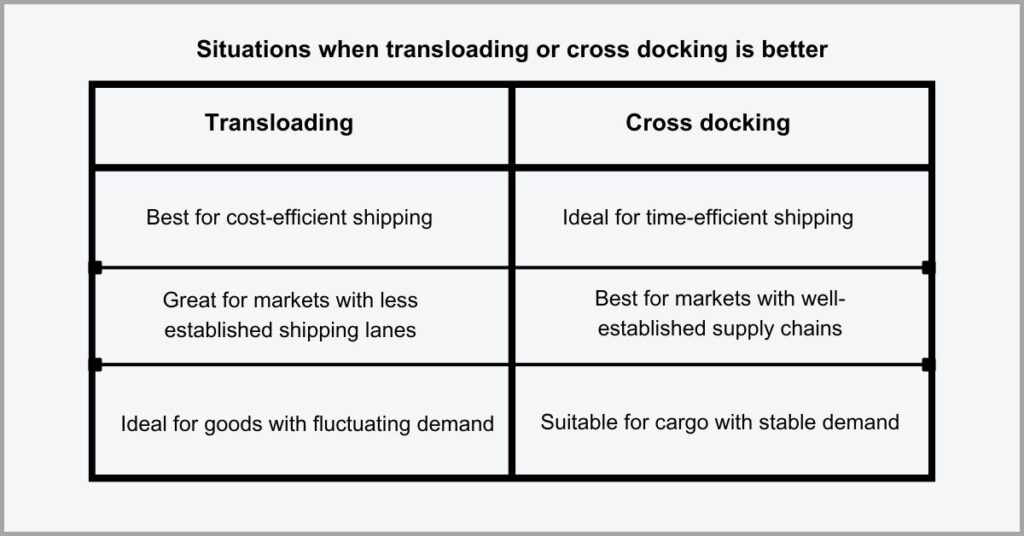
Beyond that, this form of shipping also gives you access to shipping partners who can help you improve the flow of goods in new markets. So you can leverage their existing infrastructure when setting up new shipping lines in uncharted waters.
Speaking of partners, transloads.co can also be a priceless ally for your business.
Click here to get our premium support services, which can help you set up a transload warehouse for success and thrive in a new region.
That said, cross docking is more ideal if you’re moving goods in markets where you’re dominant and already have well-established supply chains to work with.
c) Consider product demand
What is the demand of the goods you’re shipping?
When examining your options in the transloading vs cross docking debate, assessing product demand is important. It will help you choose a shipping strategy that’s most profitable for your business depending on your shipment volume.
For example, cross docking may be unsuitable when shipping goods with huge demand fluctuations because it can lead to long wait times for your clients.
This is where transload shipping proves the superior option, because of how it enables you to perform less than container load or less than truckload shipping, which is made possible by more elaborate freight consolidation and deconsolidation.
Alternatively, cross docking is more beneficial if your products have stable demand, and it’s one of the top warehouse management trends with regard to non-seasonal goods.
For cargo that enjoy relatively stable market demand, you’ll be able to move larger shipments with ease. You won’t need to wait too long to merge multiple orders for your clients, and this ensures that you can attain full truck loads with ease.
This is important because in cross docking, carriers often dedicate an entire truckload to one shipment, so being able to generate this shipment volume ensures great ROI.
Conclusion
Both transloading & cross docking are top logistics strategies.
However, making a poor decision can lead to disaster for your business.
For instance, cross docking can attract complex coordination and logistics because of the need to match truck arrival times and inbound cargo schedules.
A survey by Indago revealed that 33.3% of businesses classify their logistics as very complex. Choosing the wrong shipping strategy will only aggravate this situation and decrease your supply chain’s efficiency.
This is why we’ve examined the transloading vs cross docking discussion to help you know when to use each strategy to simplify logistics. Speaking of which, investing in the right warehouse management software can also help achieve this.
Click here to start your free transloads.co trial to use our platform to simplify logistics management for your small business.
By enabling you to digitize shipping documents and track outbound and inbound cargo, our software can improve cross docking and transloading logistics for your business.

